前言
上期详细讲解了 顺序表和链表,这期就来刷点题加深理解吧
对小白来说,很多思路也许给人感觉:“啊呀,这哪是碳基生物想得出来的!”
我也感同身受,所以停下狂奔的脚步,耐下心细细咀嚼顺序表、链表实现。旧题重做,很有一种清晰通透的爽快:
思路好像也没那么难想,实现起来也一气呵成了
本期概览
1.顺序表OJ
题目
题1 合并有序数组

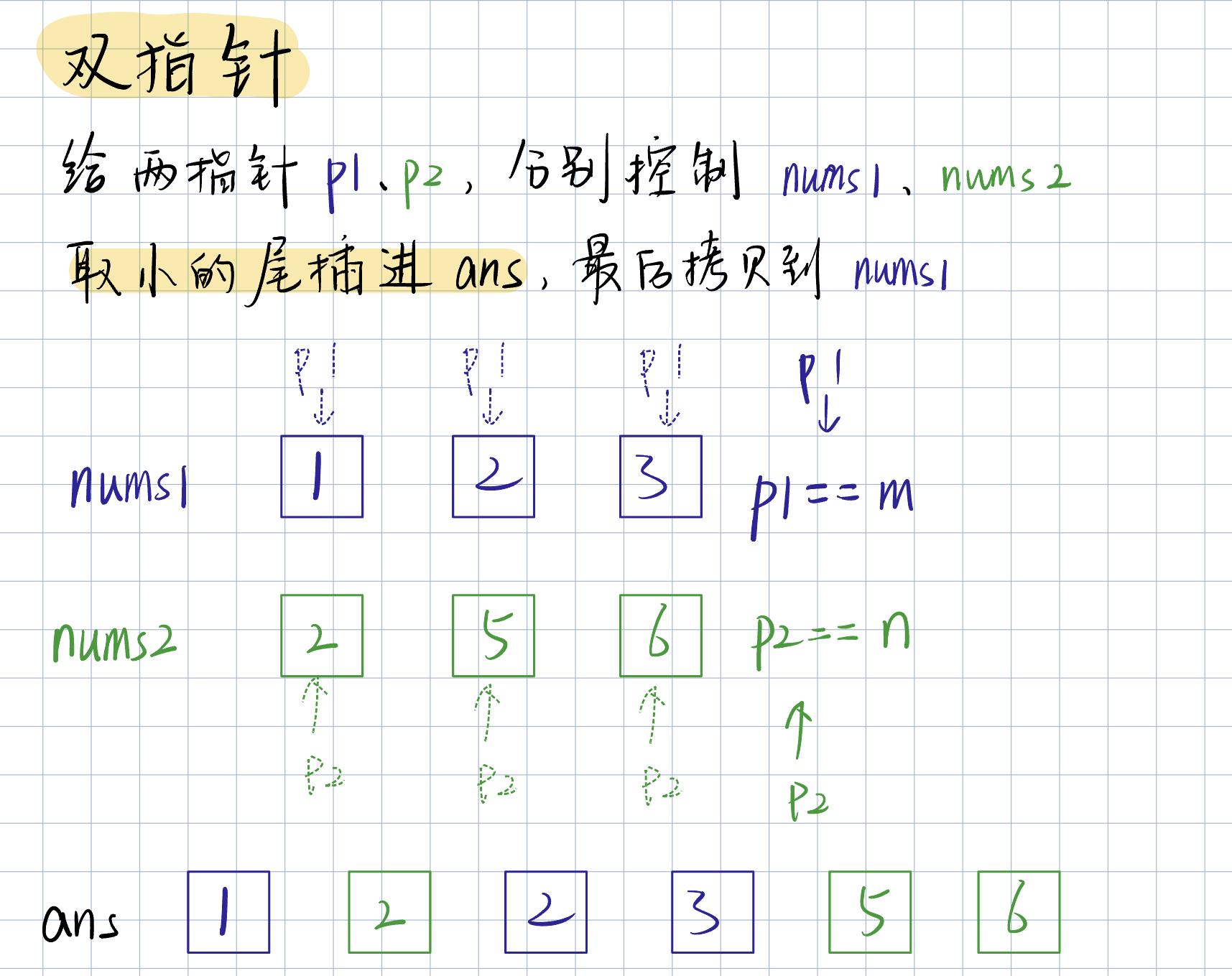
void merge(int* nums1, int nums1Size, int m, int* nums2, int nums2Size, int n)
{
int p1 = 0;
int p2 = 0;
int* ans = (int*)malloc(sizeof(int) * (m+n));
int i = 0;
for(i=0; i<m+n; i++)
{
//谁小就尾插到ans,谁放完就放另一个
if(p1 == m)//nums1拿完了
ans[i] = nums2[p2++];//拿nums2
else if(p2 == n)//nums2拿完了
ans[i] = nums1[p1++];//拿nums1
else if(nums1[p1] < nums2[p2])
ans[i] = nums1[p1++];
else
ans[i] = nums2[p2++];
}
for(i=0; i<m+n; i++)
{
nums1[i] = ans[i];
}
}
- 需要考虑某一数组拿完的情况,否则会越界访问
来源:leetcode-88.
2.链表OJ
题目
题1 移除链表元素
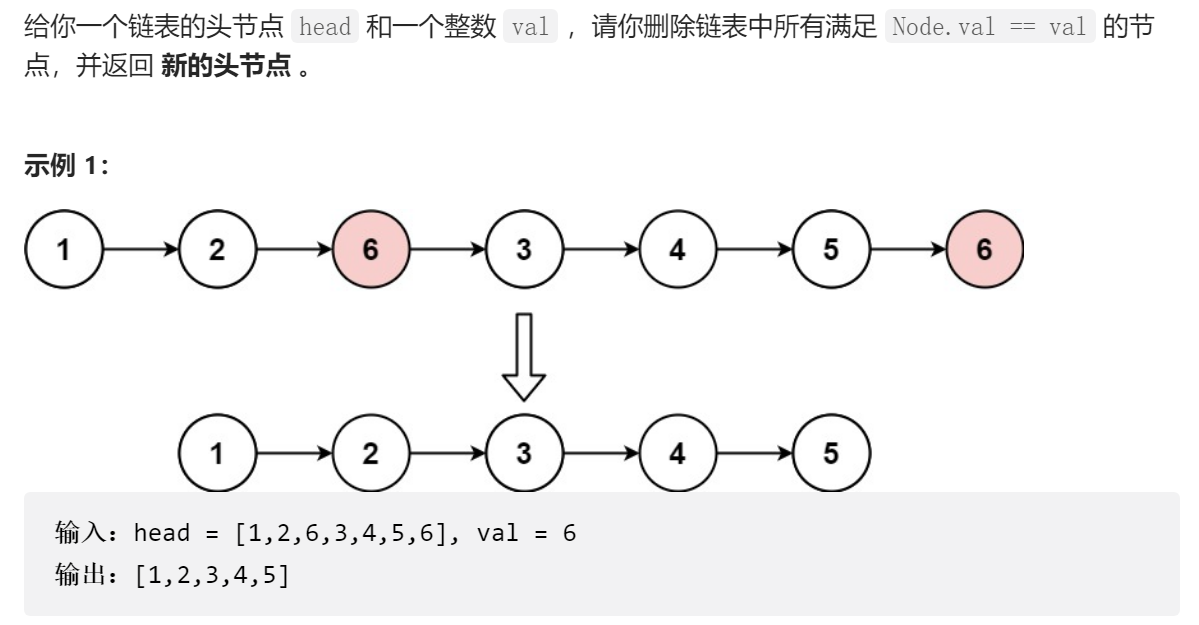

其实就是 指定删,但实现上有些容易出错的地方,分别看看吧
- 带头单向非循环:
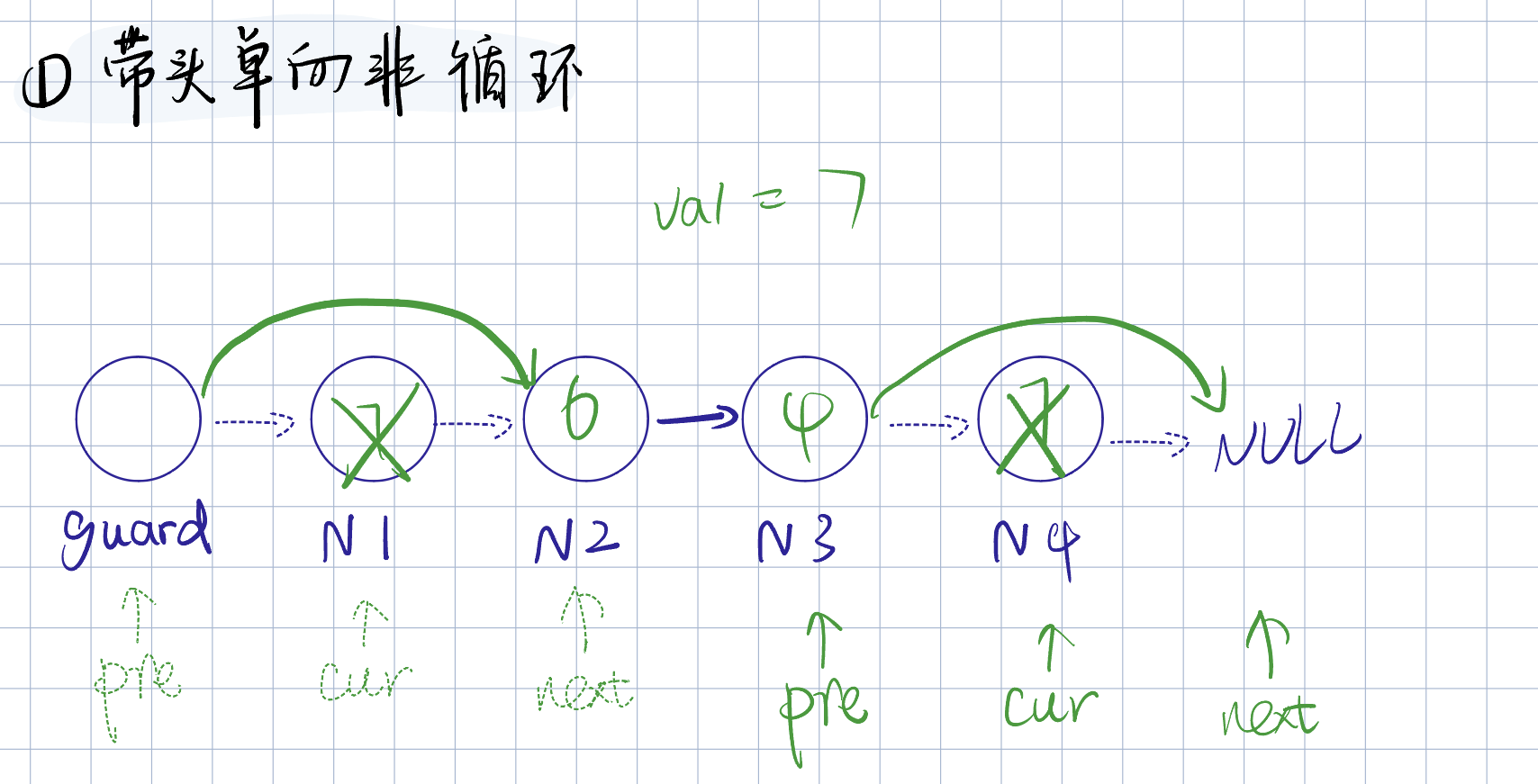
struct ListNode* removeElements(struct ListNode* head, int val)
{
if(head == NULL)
return NULL;
struct ListNode* guard = (struct ListNode*)malloc(sizeof(struct ListNode));
guard->next = head;
struct ListNode* pre = guard;
struct ListNode* cur = head;
while(cur)
{
struct ListNode* next = cur->next;
//如果cur是要删除的结点
//链接pre和next
if(cur->val == val)
{
pre->next = next;
free(cur);
cur = next;
}
else
{
pre = cur;
cur = cur->next;
}
}
struct ListNode* tmp = guard->next;
free(guard);
return tmp;
}
分析:
- 带头则不需要考虑删除第一个结点的问题
- 要释放guard,因此临时保存guard->next并返回
不带头单向非循环:
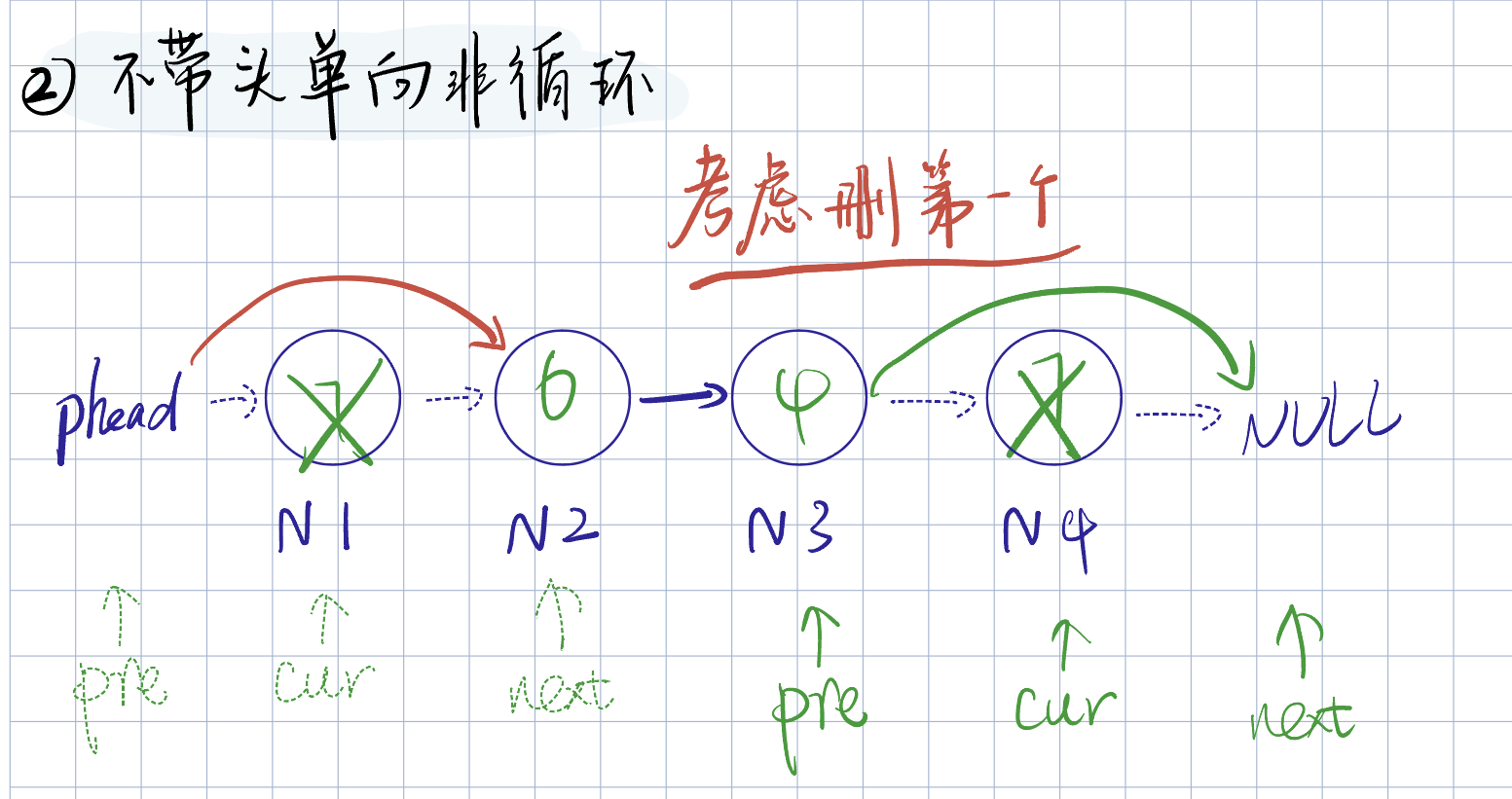
struct ListNode* removeElements(struct ListNode* head, int val)
{
struct ListNode* prev = NULL;
struct ListNode* cur = head;
struct ListNode* next = NULL;
while(cur)
{
next = cur->next;
if(cur->val == val)
{
if(prev == NULL)//头删直接改head
{
head = head->next;
}
else
{
prev->next = next;
free(cur);
}
//移除元素不用动prev:如果 prev 被赋成 cur,等会 prev->next 就出问题
cur = next;
}
else
{
prev = cur;
cur = next;
}
}
return head;
}
- 分析:
- 不带头需要考虑 删除第一个结点
- 不能解引用 free 掉的指针
题2 反转链表
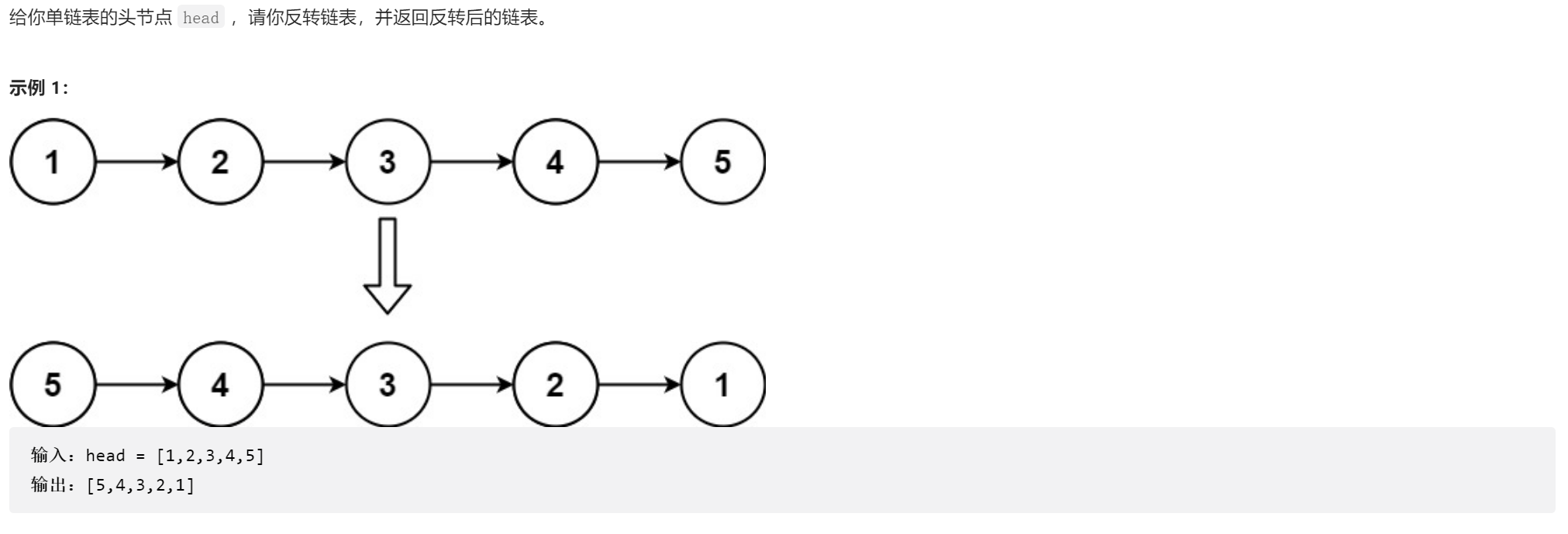
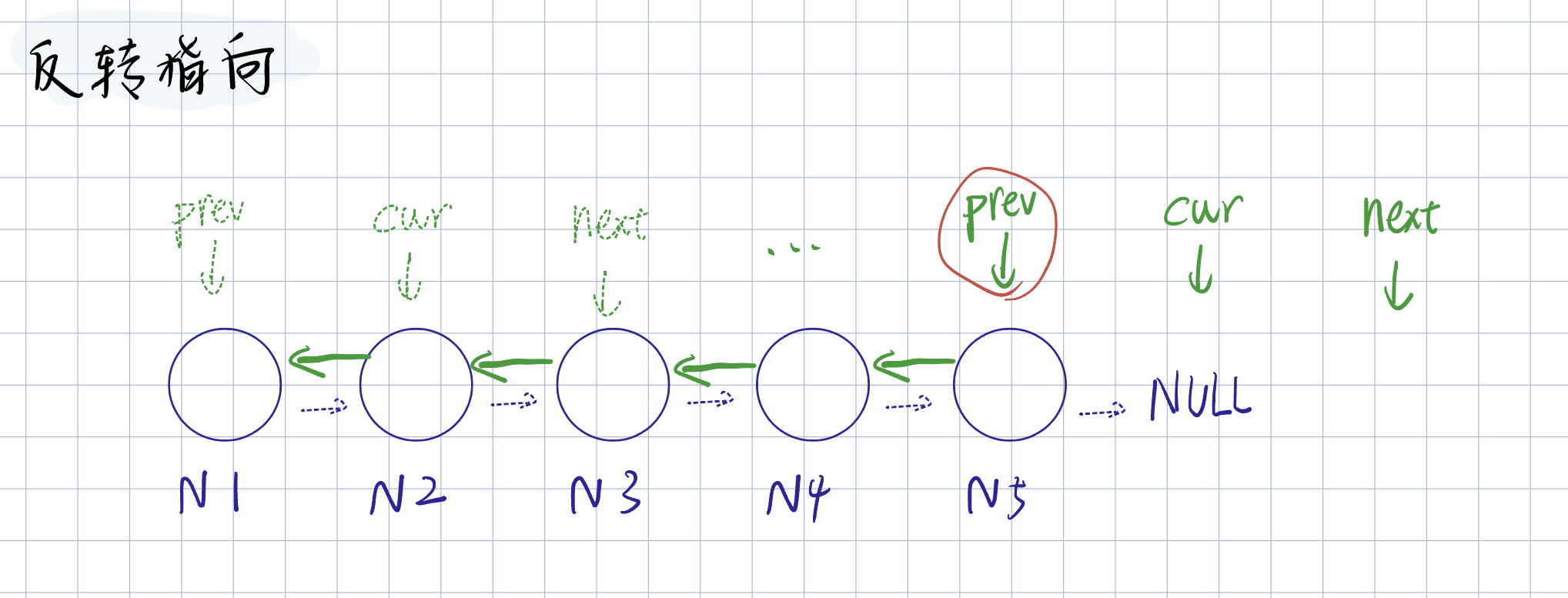
struct ListNode* reverseList(struct ListNode* head)
{
struct ListNode* prev = NULL;
struct ListNode* cur = head;
struct ListNode* next = NULL;
while(cur)
{
next = cur->next;
cur->next = prev;
prev = cur;
cur = next;
}
return prev;
}
题3 链表的中间结点

思路1:

- 遍历的思路比较容易想到,但要考虑长度奇数还是偶数,时间复杂度也高,所以我们倾向探索更好的思路
思路2:

- 快慢指针就很好地解决问题,时间复杂度低,而且实现也简单
- 画出奇数和偶数长度的链表,发现
- 奇数:stop: fast->next == NULL
- 偶数:stop: fast == NULL
struct ListNode* middleNode(struct ListNode* head)
{
struct ListNode* fast = head;
struct ListNode* slow = head;
while(fast && fast->next)
{
fast = fast->next->next;
slow = slow->next;
}
return slow;
}
题4 链表中倒数第k个结点

思路1:
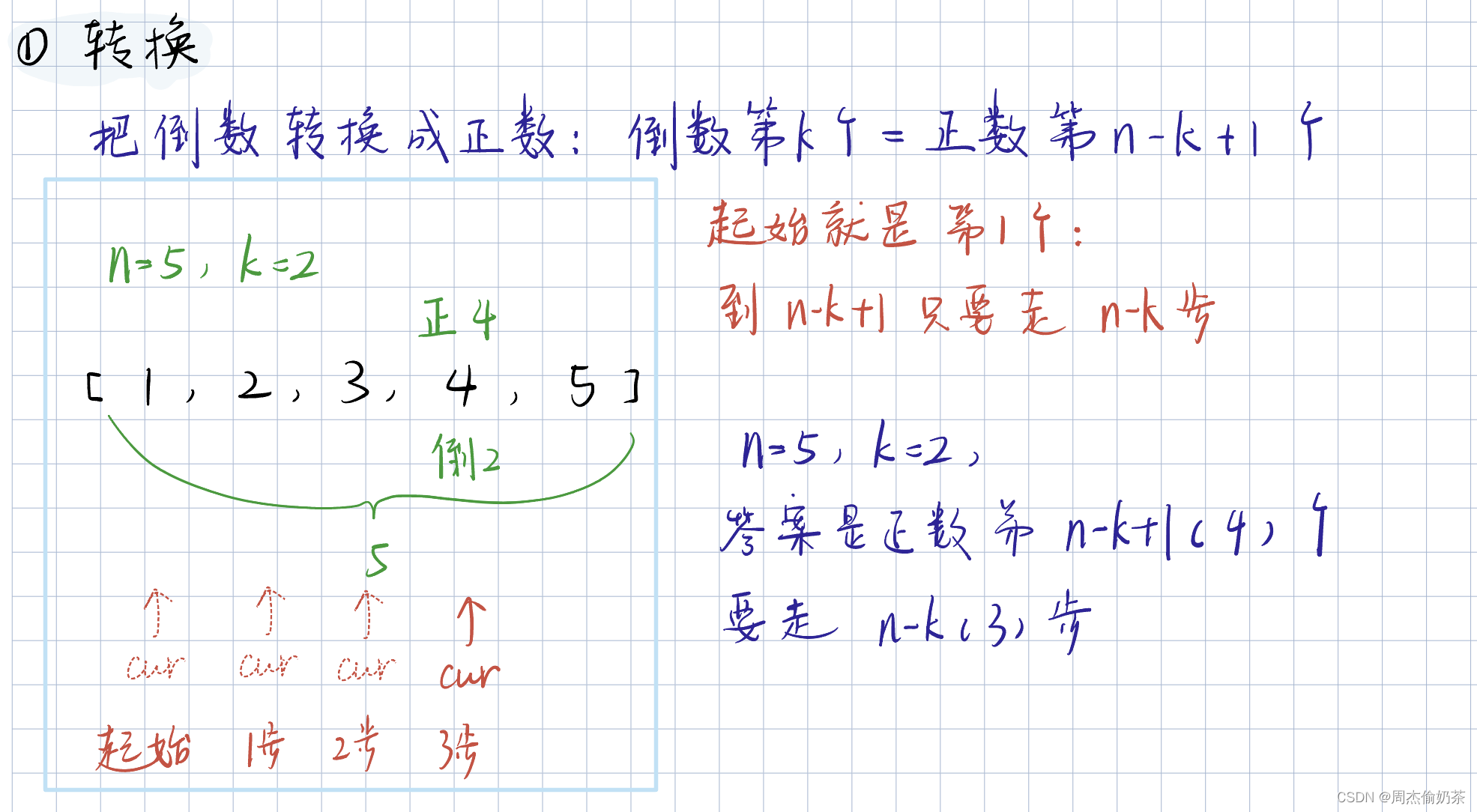
struct ListNode* FindKthToTail(struct ListNode* pListHead, int k )
{
struct ListNode* cur = pListHead;
int n = 0;
while(cur)
{
n++;
cur = cur->next;
}
if(k > n || k == 0)
return NULL;
cur = pListHead;
int gap = n-k;
while(gap--)
{
cur = cur->next;
}
return cur;
}
思路2:
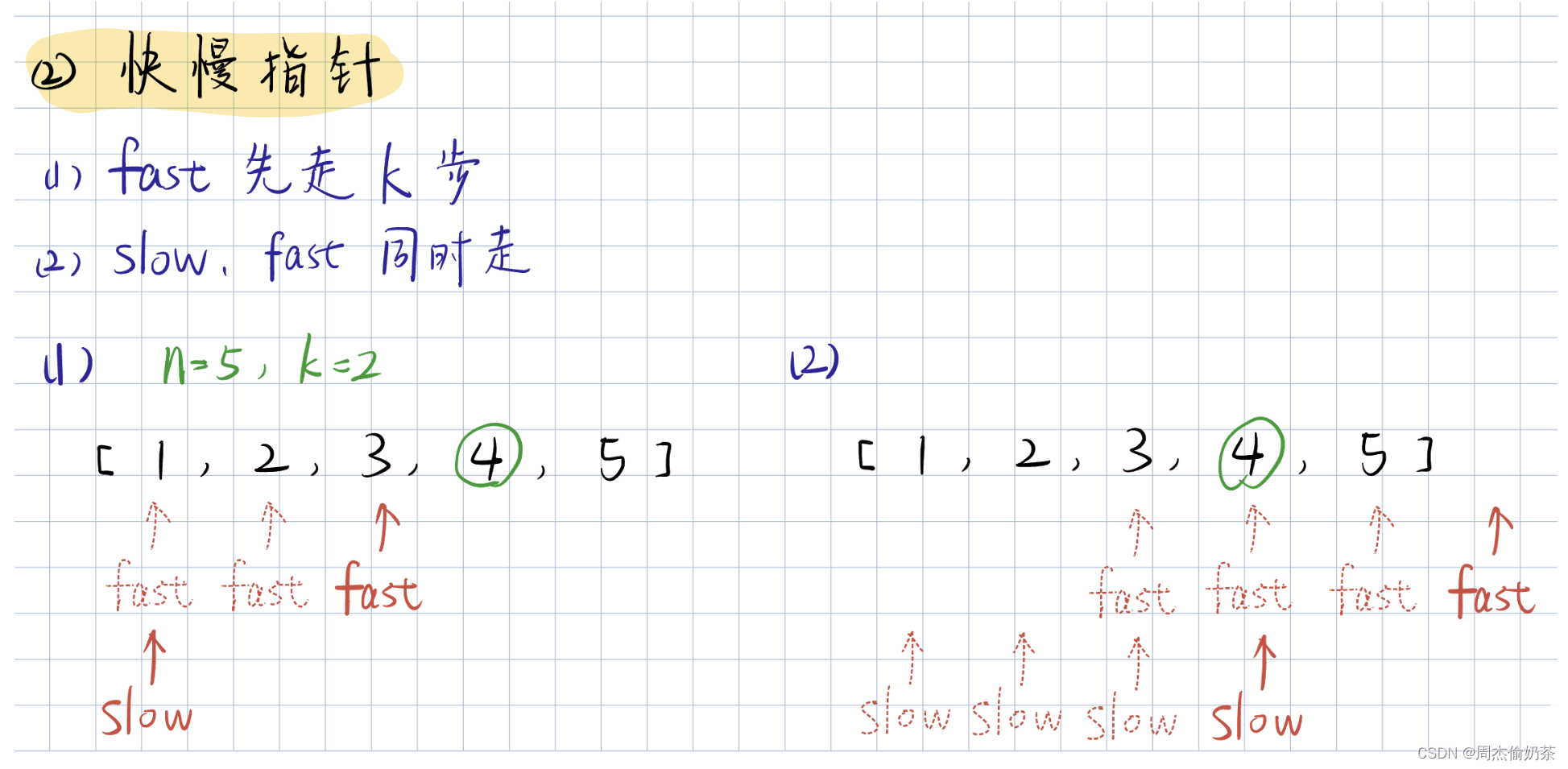
struct ListNode* FindKthToTail(struct ListNode* pListHead, int k )
{
struct ListNode* fast = pListHead;
struct ListNode* slow = pListHead;
while(k--)
{
if(fast == NULL)
return NULL;
fast = fast->next;
}
while(fast)
{
slow = slow->next;
fast = fast->next;
}
return slow;
}
来源:newcoder
题5 合并有序链表
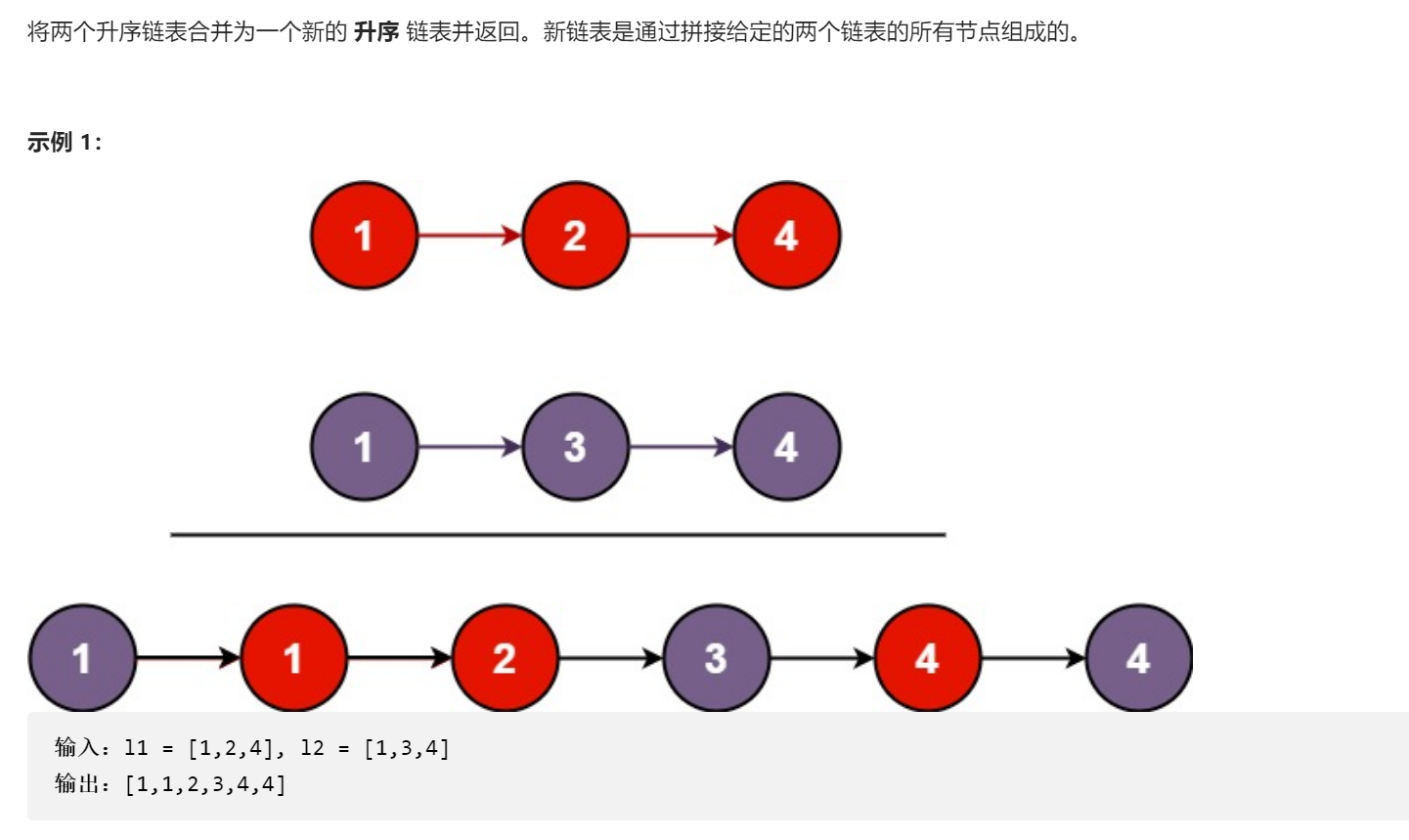
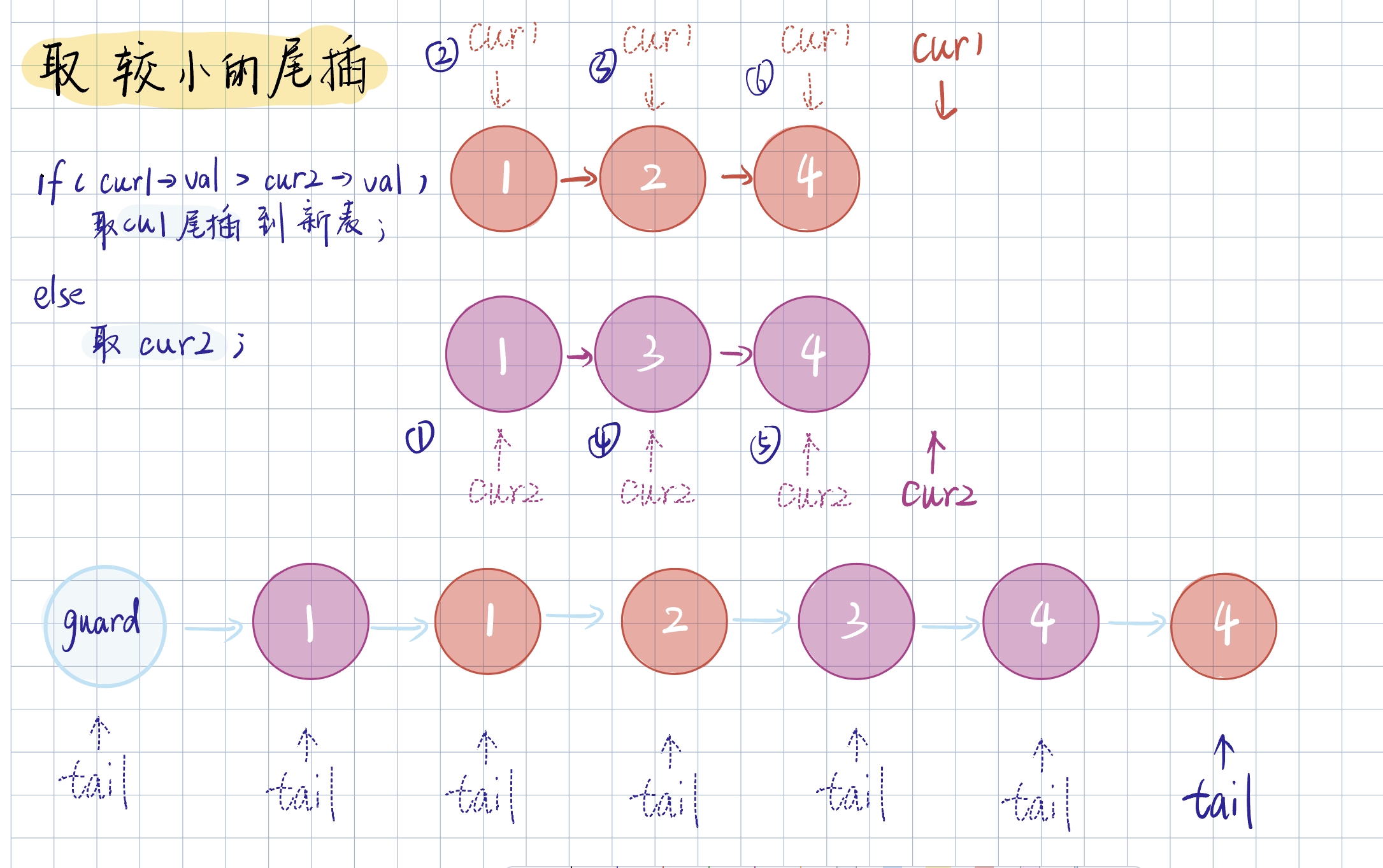
- 还需要考虑某一个链表没用完,剩了元素:谁没用完就把谁直接链接到新链表的尾部
- 带头链表的重点:guard->next要置空,不然一切空指针情况都会出bug
struct ListNode* mergeTwoLists(struct ListNode* list1, struct ListNode* list2)
{
//取小的尾插
struct ListNode* guard = (struct ListNode*)malloc(sizeof(struct ListNode));
struct ListNode* tail = guard;
struct ListNode* cur1 = list1;
struct ListNode* cur2 = list2;
guard->next = NULL;//考虑空链表情况
while(cur1 && cur2)
{
if(cur1->val < cur2->val)
{
tail->next = cur1;
tail = tail->next;
cur1 = cur1->next;
}
else
{
tail->next = cur2;
tail = tail->next;
cur2 = cur2->next;
}
}
//如果是list1没尾插完
if(cur1)
{
tail->next = cur1;
}
//如果是list2没尾插完
if(cur2)
{
tail->next = cur2;
}
struct ListNode* newhead = guard->next;//链表为空这里出问题
free(guard);
return newhead;
}
来源:leetcode-21.
题6 链表分割

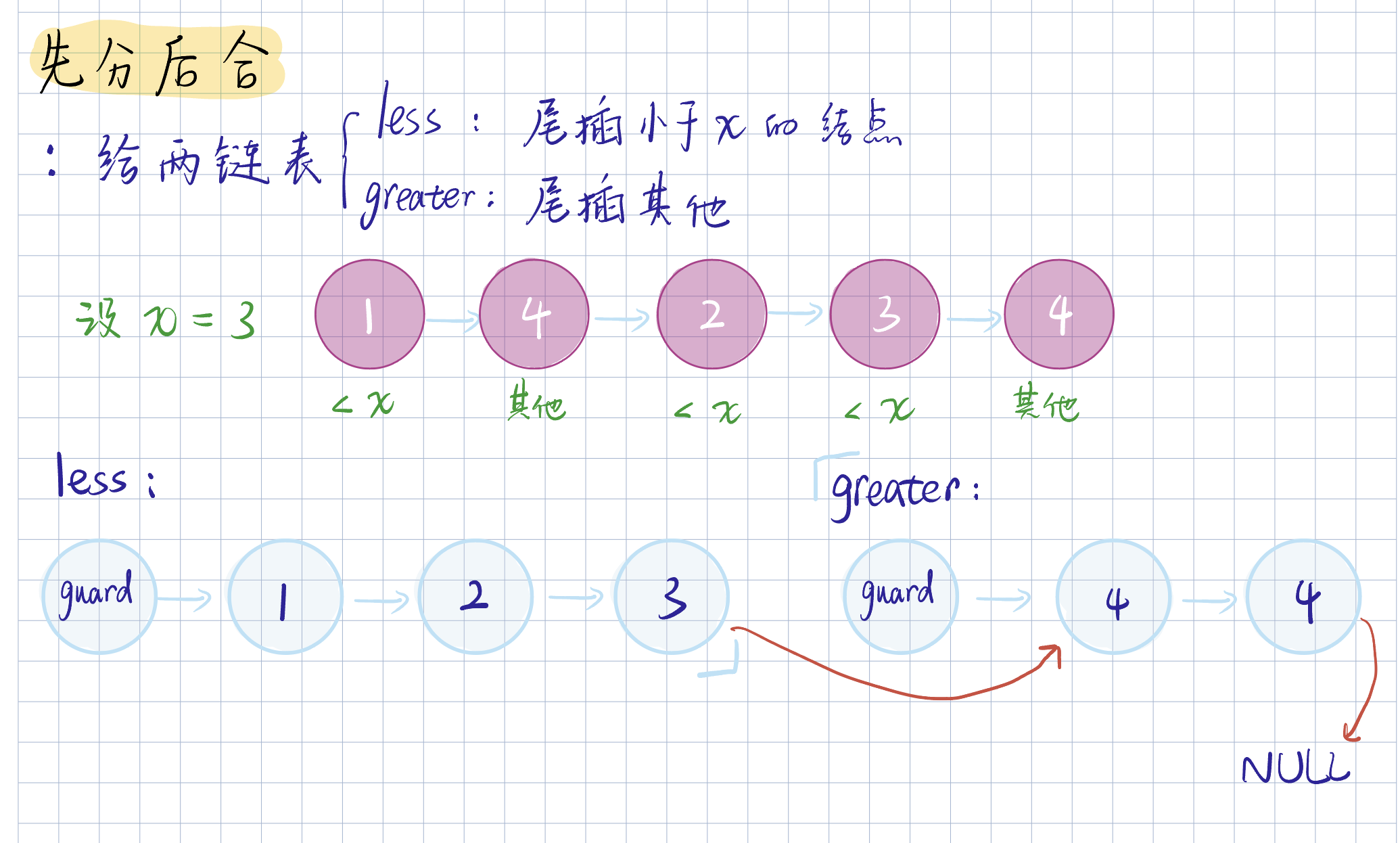
- 链接是这道题容易疏忽的地方:
- 带头链表的初始化
- less_guard->next = NULL;
- greater_guard->next = NULL;
- 结果链表的尾部指向空
- 带头链表的初始化
ListNode* partition(ListNode* pHead, int x)
{
//小于x,放到less;其他放到greater
struct ListNode* less_guard = (struct ListNode*)malloc(sizeof(ListNode));
struct ListNode* greater_guard = (struct ListNode*)malloc(sizeof(ListNode));
less_guard->next = NULL;//应对空链表
greater_guard->next = NULL;//应对空链表
struct ListNode* less_tail = less_guard;
struct ListNode* greater_tail = greater_guard;
struct ListNode* cur = pHead;
while(cur)
{
if(cur->val < x)
{
less_tail->next = cur;
less_tail = less_tail->next;
}
else
{
greater_tail->next = cur;
greater_tail = greater_tail->next;
}
cur = cur->next;
}
//链接:尾要指向空
less_tail->next = greater_guard->next;
greater_tail->next = NULL;
struct ListNode* newhead = less_guard->next;
free(less_guard);
free(greater_guard);
return newhead;
}
来源:newcoder
题7 链表的回文结构
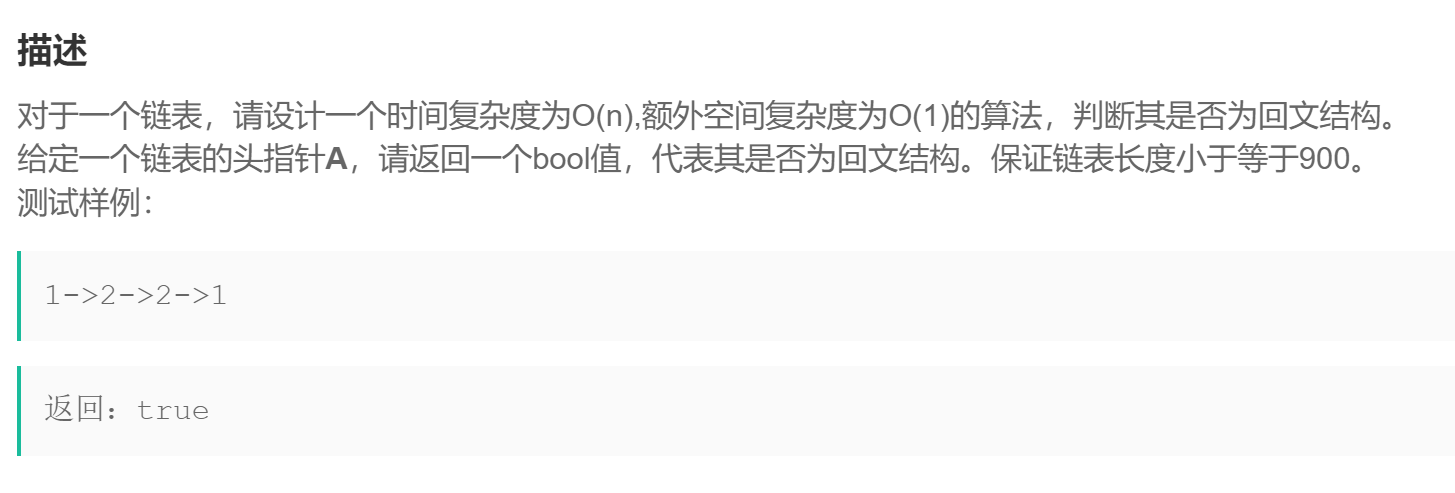
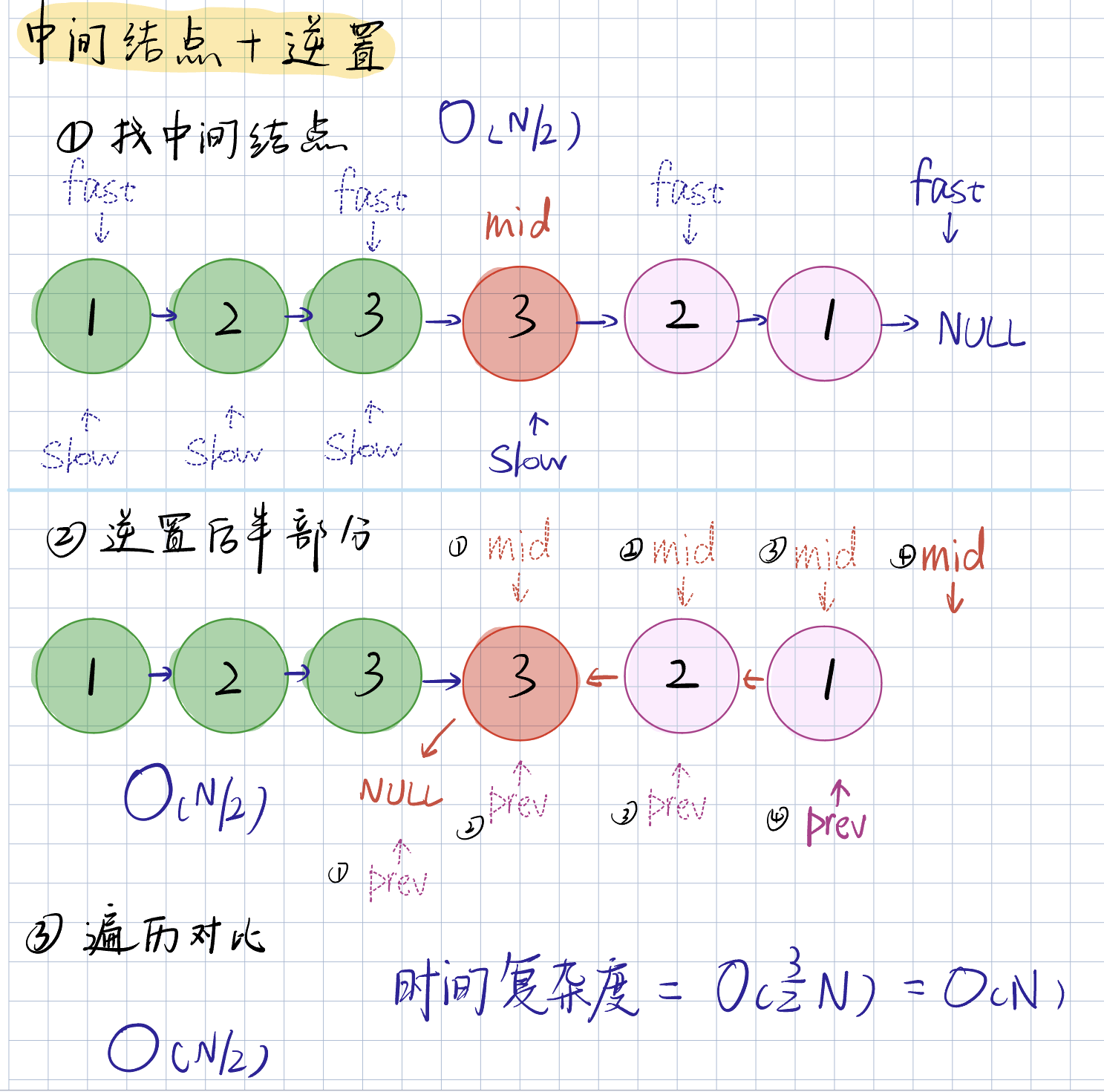
- 前面的 中间结点 和 逆置链表 如果掌握扎实,这道题的思路会自动浮现在你脑海了
- 如果没有时间复杂度的要求,更简单的思路就是 逆置整个链表,和原链表对比
bool chkPalindrome(ListNode* phead)
{
//找中间结点
struct ListNode* fast = phead;
struct ListNode* slow = phead;
struct ListNode* mid = NULL;
while(fast && fast->next)
{
fast = fast->next->next;
slow = slow->next;
}
mid = slow;
//逆置后半部分
struct ListNode* prev = NULL;
struct ListNode* next = NULL;
while(mid)
{
next = mid->next;
mid->next = prev;
prev = mid;
mid = next;
}
//此时prev指向逆置的后半部的头
//两边向中间遍历对比
while(prev)
{
if(phead->val != prev->val)
return false;
phead = phead->next;
prev = prev->next;
}
return true;
}
来源:newcoder
题8 相交链表

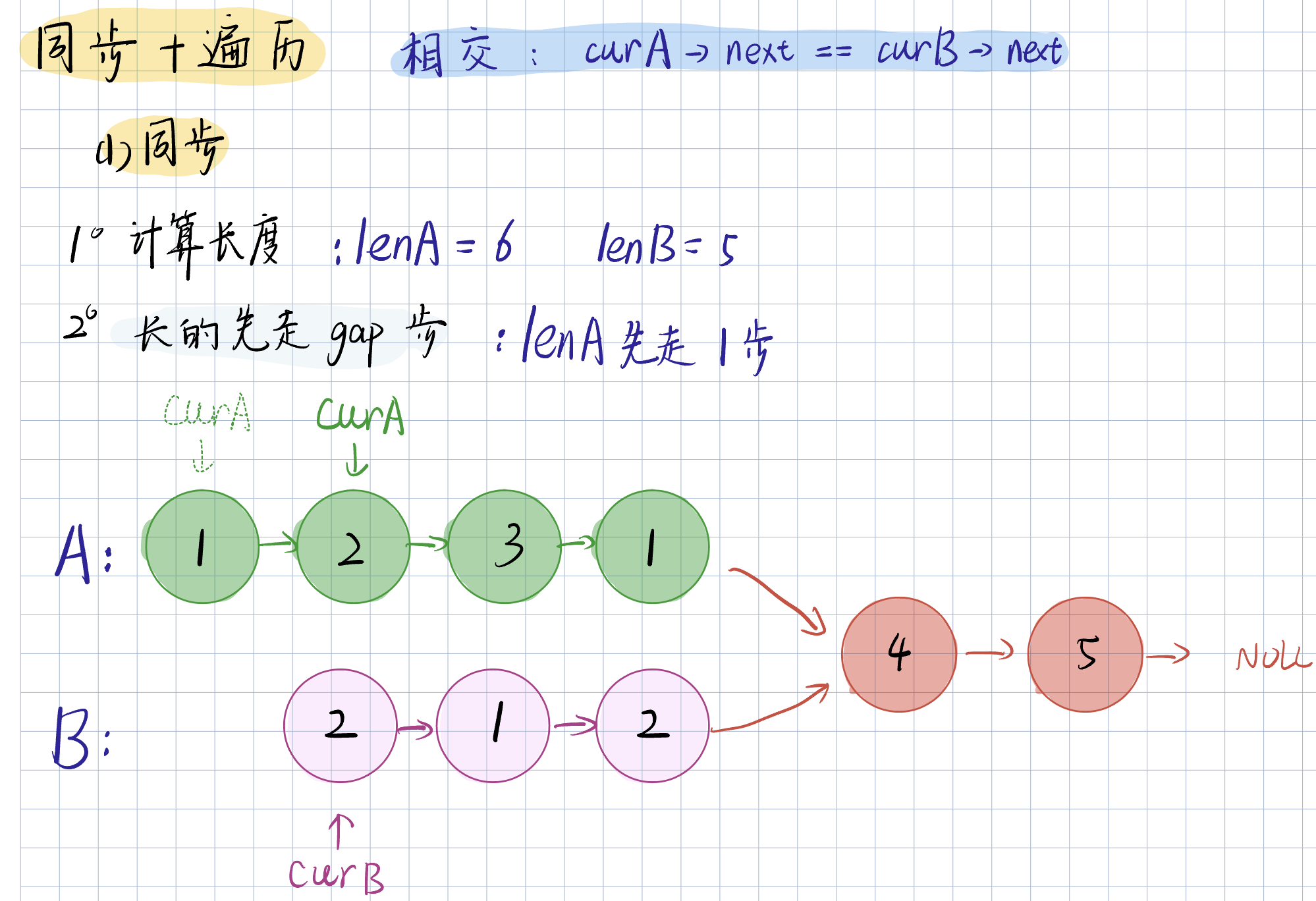
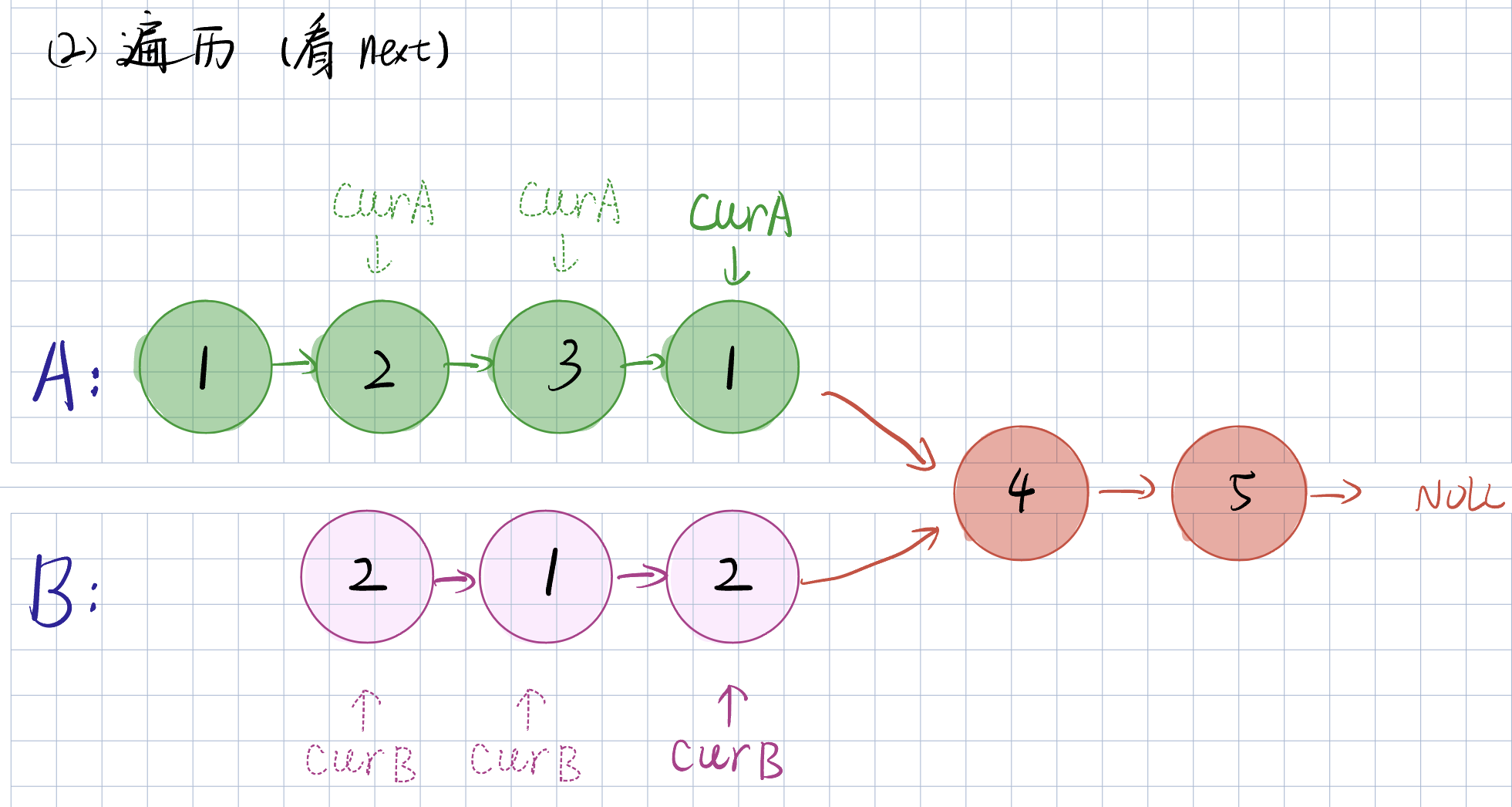
- 做来做去都是操作一下链表指针呢
struct ListNode *getIntersectionNode(struct ListNode *headA, struct ListNode *headB)
{
//长的先走gap步
//计算长度
int lenA = 0;
int lenB = 0;
struct ListNode* curA = headA;
struct ListNode* curB = headB;
while(curA)
{
lenA++;
curA = curA->next;
}
while(curB)
{
lenB++;
curB = curB->next;
}
int gap = abs(lenA-lenB);
//假设A长
struct ListNode* fast = headA;
struct ListNode* slow = headB;
//否则B长
if(lenB > lenA)
{
fast = headB;
slow = headA;
}
while(gap--)
{
fast = fast->next;
}
//一起走:next相同就相交
while(fast)//fast slow 都一样
{
if(fast == slow)
return fast;
if(fast->next == slow->next)
return fast->next;
fast = fast->next;
slow = slow->next;
}
return NULL;
}
题9 环形链表


- 这题还是快慢指针:如果有环,fast先进环,slow后进环,最终fast套了 N(N>=0)圈后相遇
bool hasCycle(struct ListNode *head)
{
struct ListNode* fast = head;
struct ListNode* slow = head;
while(fast && fast->next)
{
fast = fast->next->next;
slow = slow->next;
if(fast == slow)
return true;
}
return false;
}
题10 环形链表2
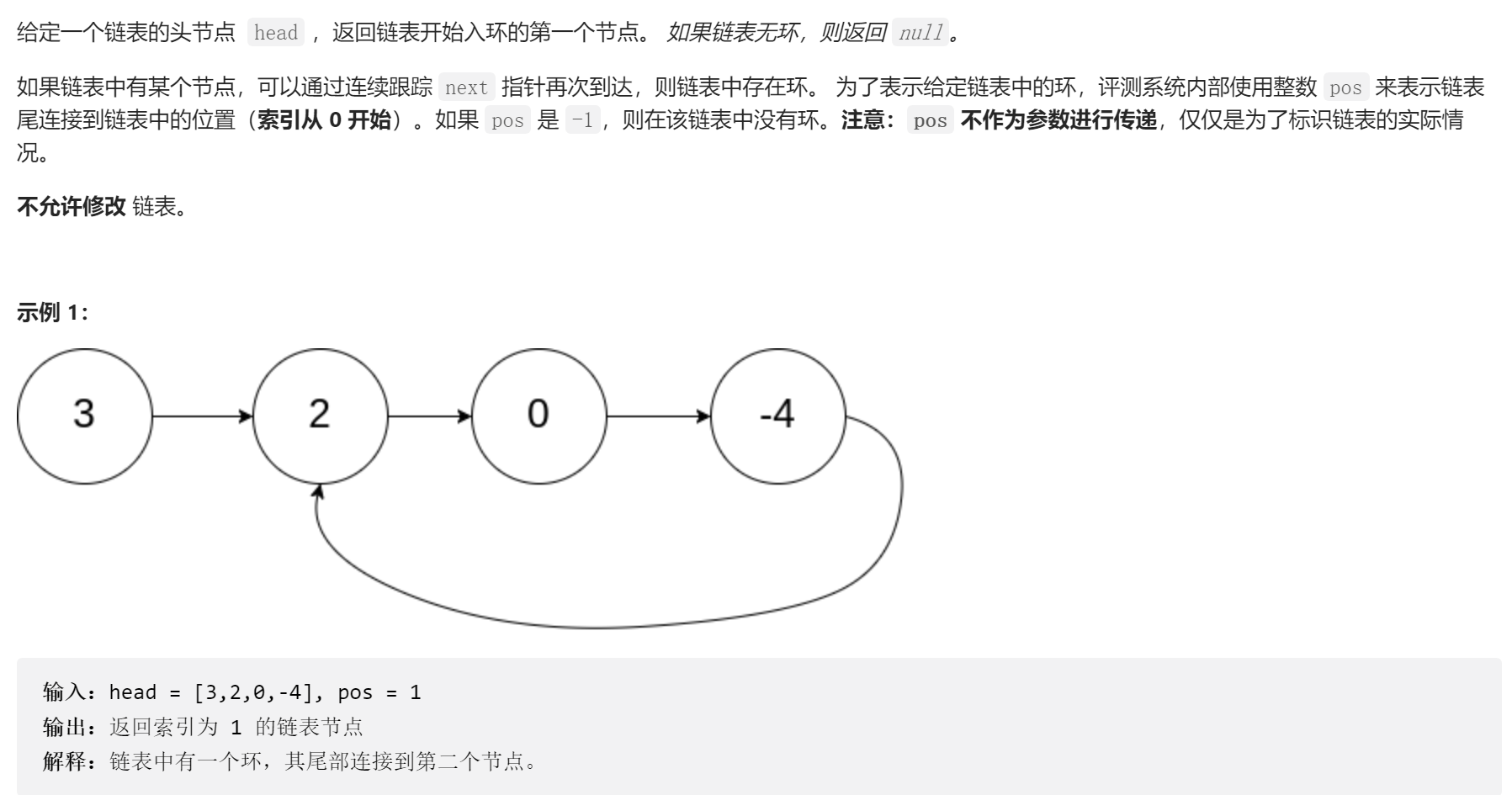
思路1:
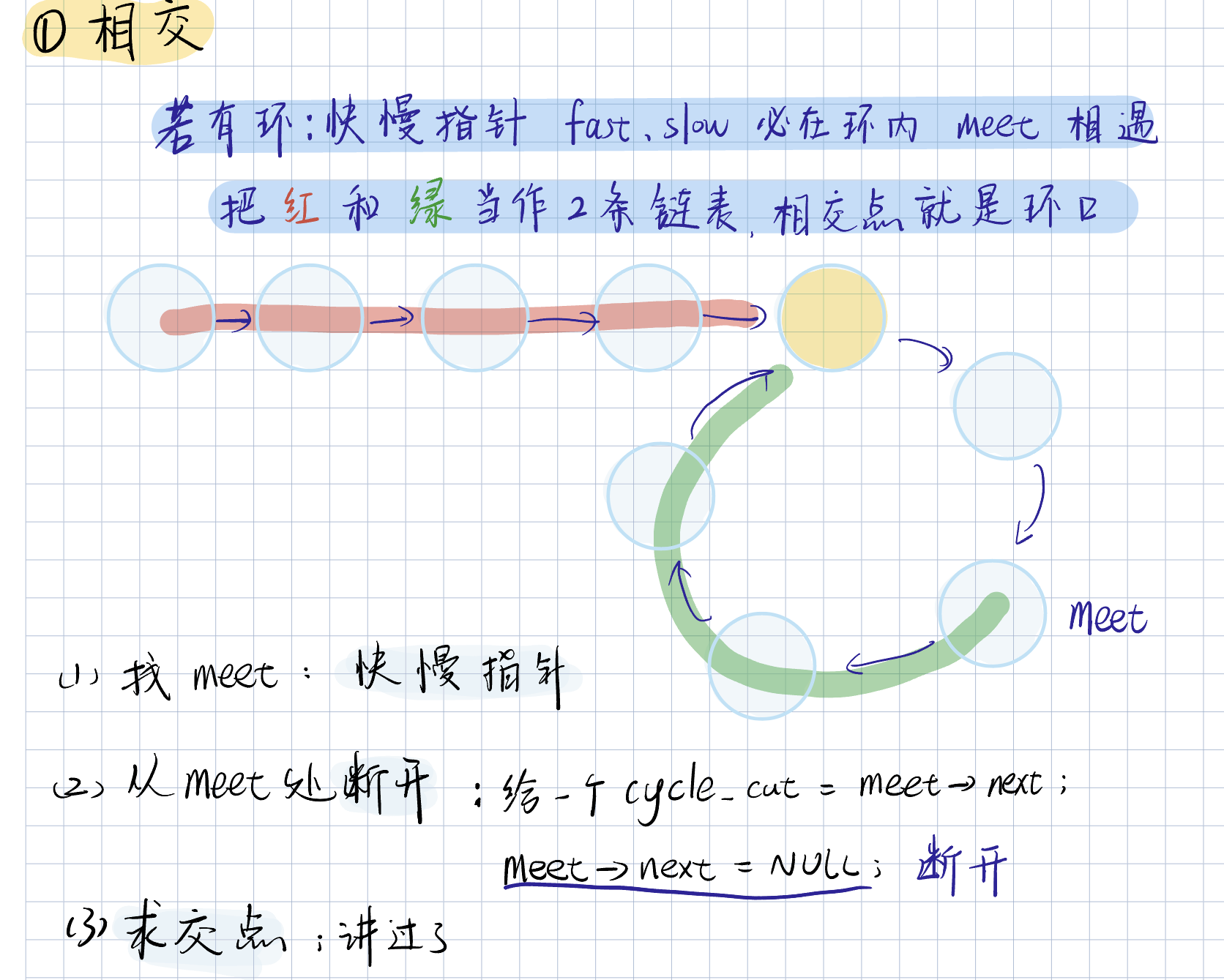
struct ListNode *getIntersectionNode(struct ListNode *headA, struct ListNode *headB)
{
//长的先走gap步
//计算长度
int lenA = 0;
int lenB = 0;
struct ListNode* curA = headA;
struct ListNode* curB = headB;
while(curA)
{
lenA++;
curA = curA->next;
}
while(curB)
{
lenB++;
curB = curB->next;
}
int gap = abs(lenA-lenB);
//假设A长
struct ListNode* fast = headA;
struct ListNode* slow = headB;
//否则B长
if(lenB > lenA)
{
fast = headB;
slow = headA;
}
while(gap--)
{
fast = fast->next;
}
//一起走:next相同就相交
while(fast)//fast slow 都一样
{
if(fast == slow)
return fast;
if(fast->next == slow->next)
return fast->next;
fast = fast->next;
slow = slow->next;
}
return NULL;
}
struct ListNode *detectCycle(struct ListNode *head)
{
//有环,快慢指针肯定有相遇点,相遇点肯定在圈内
//1.从相遇点断开,cycle_cut = meet->next; meet->next = NULL
struct ListNode* fast = head;
struct ListNode* slow = head;
struct ListNode* meet = NULL;
while(fast && fast->next)
{
fast = fast->next->next;
slow = slow->next;
if(fast == slow)
break;
}
if(fast == NULL || fast->next == NULL)
return NULL;
//断开
struct ListNode* cycle_cut = fast->next;
fast->next = NULL;
//2.看head和cycle_cut是否相交
struct ListNode* entryNode = getIntersectionNode(head, cycle_cut);
return entryNode;
}
思路2:
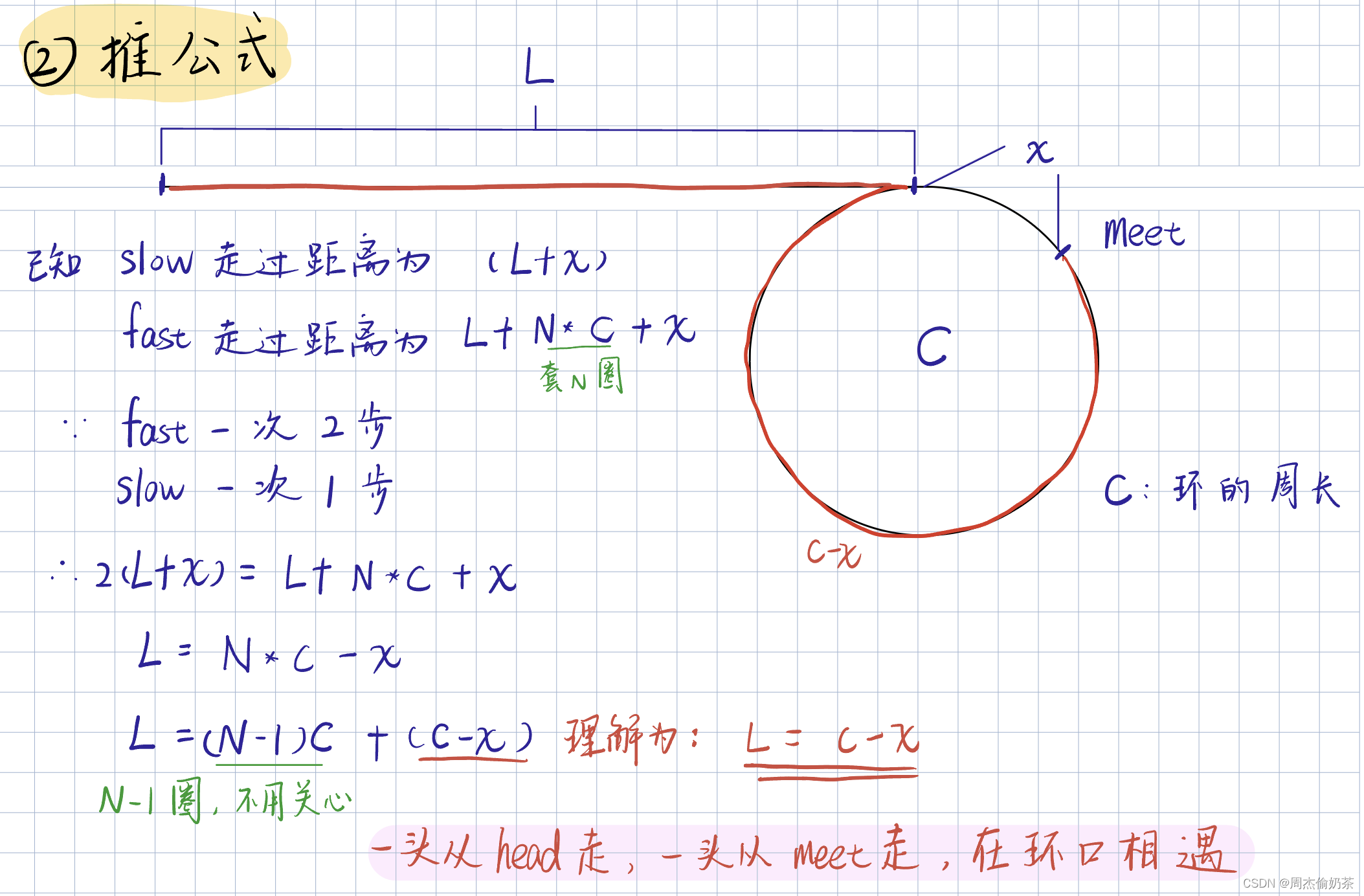
struct ListNode *detectCycle(struct ListNode *head)
{
//slow 从 head 走,fast 从 meet 走,套N圈后在入口相遇
struct ListNode* fast = head;
struct ListNode* slow = head;
struct ListNode* meet = NULL;
while(fast && fast->next)
{
fast = fast->next->next;
slow = slow->next;
if(fast == slow)
break;
}
if(fast == NULL || fast->next == NULL)
return NULL;
slow = head;
while(slow)
{
if(slow == fast)
return slow;
slow = slow->next;
fast = fast->next;
}
return NULL;
}
题11 链表的深度拷贝


思路1:
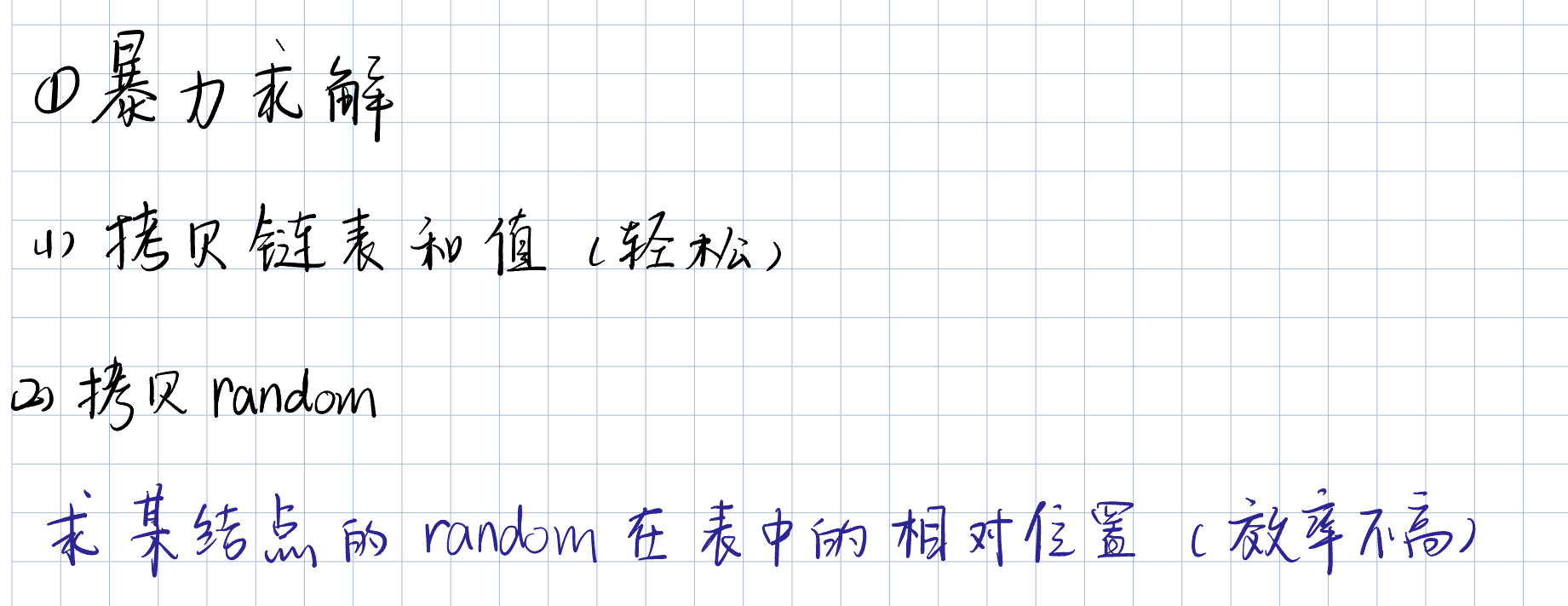
思路2:
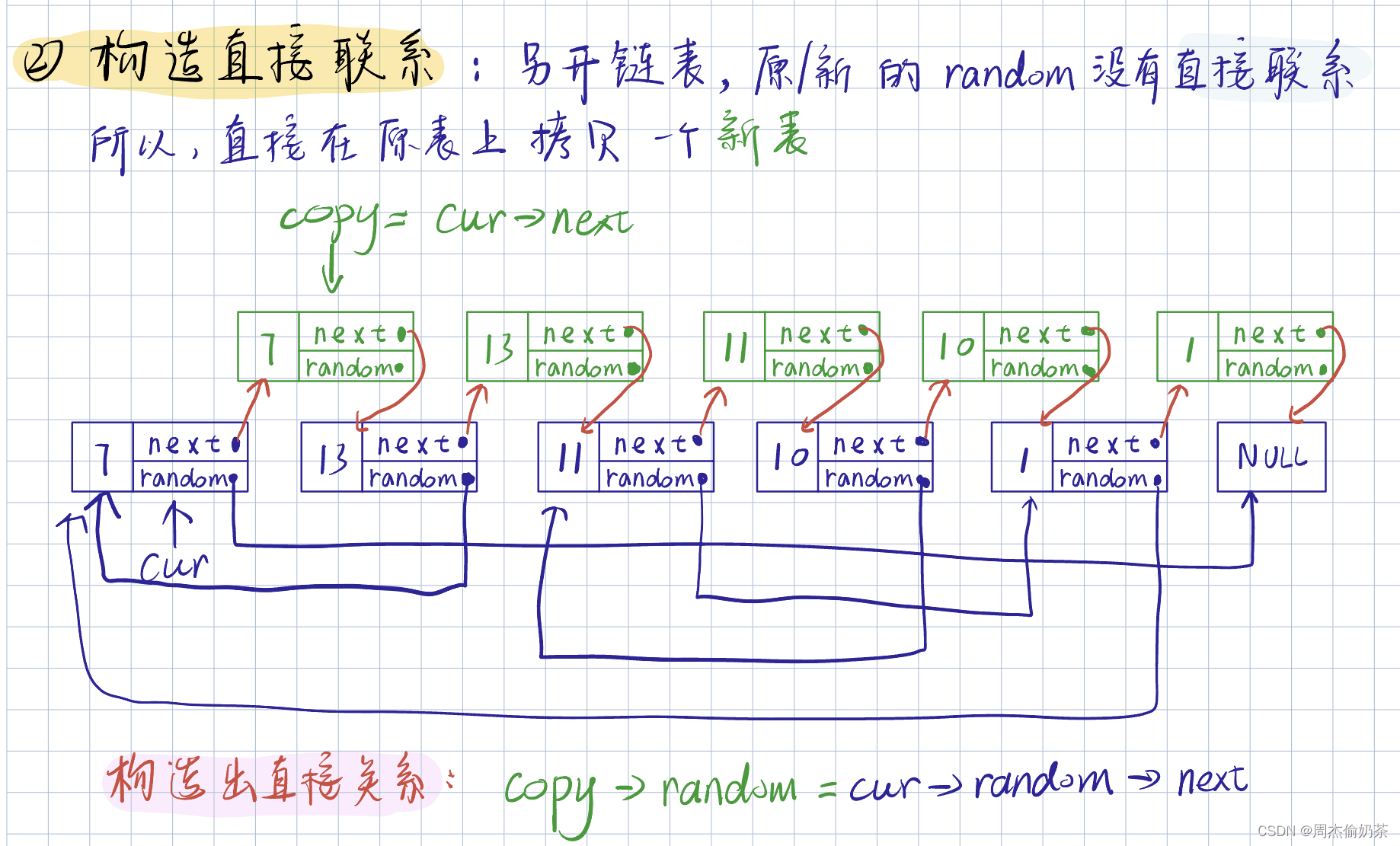
struct Node* copyRandomList(struct Node* head)
{
//1.插新链表并拷贝值
struct Node* cur = head;
struct Node* copy = NULL;
struct Node* next = NULL;
while(cur)
{
next = cur->next;
copy = (struct Node*)malloc(sizeof(struct Node));
copy->val = cur->val;
cur->next = copy;
copy->next = next;
cur = next;
}
//2.拷贝新链表的random
cur = head;
while(cur)
{
copy = cur->next;
if(cur->random == NULL)
copy->random = NULL;
else
copy->random = cur->random->next;
cur = copy->next;
}
//3.断开新链表和原链表,新链表链接起来(用尾插的方式)
cur = head;
struct Node* copyHead = NULL;
struct Node* copyTail = NULL;
while(cur)
{
copy = cur->next;
next = copy->next;
//尾插
if(copyHead == NULL)
{
copyHead = copy;
copyTail = copyHead;
}
else
{
copyTail->next = copy;
copyTail = copyTail->next;
}
//恢复原链表
cur->next = next;
cur = cur->next;
}
return copyHead;
}
本期分享就到这啦,不足之处望请斧正
本文含有隐藏内容,请 开通VIP 后查看